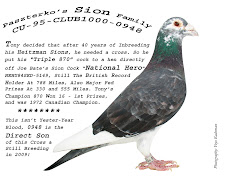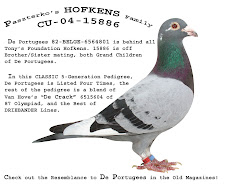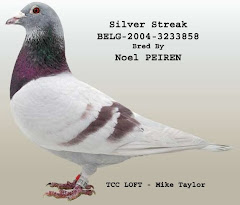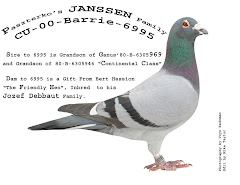Saturday, December 17, 2011
Completed Moult
Thursday, December 15, 2011
History of Racing Pigeons
Saturday, December 10, 2011
Pigeons under attack in Moss Park
Read more ...
Friday, December 9, 2011
Jim Jenner's pigeons
The Rotarian -- December 2011

Fifth grader Kane, with Jenner, is among the Philipsburg, Montana, students taking part in Young Wings. Photo by John Nilles
“I’ve heard every joke,” says Jim Jenner. Those laughs come at the expense of Columba livia, or the rock dove – also known as the humble pigeon. Jenner bristles at the bird’s bad PR, particularly Woody Allen’s famous characterization of pigeons as “rats with wings.”
With their uncanny ability to find their way home from hundreds of miles away, pigeons deserve a little respect, says Jenner, an award-winning filmmaker whose 1990 documentary, Marathon in the Sky: The Story of Pigeon Racing, remains an inspiration for hobbyists. Actor and director Michael Landon narrated the film in exchange for Jenner’s footage of birds in flight, which Landon later used in his TV movie Where Pigeons Go to Die.
Doves, which mate for life, are often a symbol of peace, but as Jenner noted during a speech to England’s House of Commons in 2005, they’ve also played a vital role during wartime, braving flak to carry code across battlefronts. One of the earliest domesticated creatures, pigeons boast a diverse group of famous fanciers, including Charles Darwin, Pablo Picasso (Paloma, his daughter’s name, is Spanish for dove), and Queen Elizabeth II. A program on the Animal Planet network, Taking on Tyson, follows former prizefighter Mike Tyson as he races his pigeons against birds owned by trash-talking wiseguys.
 Thomas, who is featured in Jenner's documentary, is part of a pigeon program in Belgium. Photo by Jim Jenner
Thomas, who is featured in Jenner's documentary, is part of a pigeon program in Belgium. Photo by Jim Jenner"Young Wings, a program Jenner started in 2009, brings children in Philipsburg, a 19th-century mining town, closer to the natural world. Through the program, children raise pigeons in a horse-trailer-turned-pigeon-loft. “This domestic creature, this wonderful, hardy, easy-to-care-for, inexpensive, and profoundly intelligent pet, can fit in with helping kids,” Jenner says.
He is completing a documentary about the program and similar projects, including one for former gang members in South Central Los Angeles and another for juvenile offenders in England.
Pigeons can help “young people become better people,” says Jenner. “I decided to make a film where I would tell a little of my own story and look for evidence that these birds can have a profound effect on children.”
Mike Cutler, superintendent of Philipsburg School District No. 1, says he’s seen how Young Wings has turned things around for some youngsters. “We’re a small community, but we have children from broken families. When those children find a love for pigeons, it kind of replaces things they may not be getting elsewhere. And it has taught the kids about the birds and the bees. It’s been a great science lesson.”
Jenner’s connection with pigeons began at age 10, when a classmate brought a cage with two street pigeons to their school in Seattle. “It was the first time a bird looked back at me,” he recalls. After talking his parents into letting him keep some birds of his own, “I had this responsibility, rain or shine, in all seasons, to take care of them. That teaches a child so much. Here I was, witnessing these very gentle, loving creatures. Their conduct with each other is a beautiful thing.”Besides, “it’s pretty neat to let something out of its cage and let it fly around the house at 50 miles per hour.”
Read more...
Sunday, December 4, 2011
How pigeons produce ‘milk’
Tuesday, 20 September 2011
Deakin University scientists have revealed some of the secrets behind the pigeon’s rare ability to produce ‘milk’ to feed its young.Deakin PhD student Meagan Gillespie and research fellow Dr Tamsyn Crowley, along with colleagues from the University’s Institute for Technology Research and Innovation and CSIRO Livestock Industries, have studied the genes behind pigeon ‘milk’ production. They found that, like mammalian milk, it contains antioxidants and immune-enhancing proteins important for the growth and development of the young.
“Producing milk to feed babies is normally the domain of mammals, including humans. However, the pigeon is one of only three bird species (the others being flamingos and male emperor penguins) to produce a milk-like substance to feed their young,” Dr Crowley explained.“We looked at the genes involved in the production of pigeon ‘milk’ and found that it contains antioxidants and immune-enhancing factors. This suggests that, like mammalian milk, it plays a key role in enhancing the immune system of the developing baby.”Both female and male pigeons produce a nutrient rich substance in their crop to feed their young (squabs). This substance has been likened to lactation in mammals and is referred to as pigeon ‘milk’. This ‘milk’ is essential for the growth and development of the pigeon squab, and without it they fail to thrive.“Bird crops are normally used to store food. However, in the pigeon the crop changes prior to ‘lactation’ in response to hormones and returns to its ‘non-lactating’ state at the end of the lactation period, a bit like the mammary gland,” Ms Gillespie explained.“During ‘lactation’, a curd-like substance is created from fat-filled cells that line the crop and regurgitated to feed the squab. This ‘milk’ contains protein, fats, minerals and antibodies to provide nutrition to the young.”While studies have investigated the nutritional value of pigeon ‘milk’, very little is known about what it is or how it is produced.“This study has provided an insight into the process of pigeon ‘milk’ production by studying the genes expressed in the ‘lactating’ crop,” Ms Gillespie said.“Birds are different to other animals in that they don’t have sweat glands, but they do have the ability to accumulate fat in their outer skin cells (keratinocytes) which act like sweat glands. We found that the evolution of pigeon ‘milk’ appears to have developed from the ability of these outer skin cells to accumulate fat.“The way pigeon ‘milk’ is produced is an interesting example of the evolution of a system with similarities to mammalian lactation, with pigeon ‘milk’ fulfilling a similar function to mammalian milk but produced in a different way.”The results of the study will be published this week in BioMed Central’s journal BMC Genomics.About pigeon ‘milk’The crop in most species of birds is normally used as a food storage area. It is located between the oesophagus and the top of a bird’s stomach where food is moistened before further breakdown and digestion through the gastrointestinal tract.The pigeon is one of only three bird species (the others being flamingos and male emperor penguins) known to produce ‘milk’ to feed their young.In pigeons the milk starts to be produced in the crop of the parent birds two days before eggs hatch.During ‘lactation’, a curd-like substance is created from fat-filled cells that line the crop and regurgitated to feed the squab. This ‘milk’ is made up of protein (around 60 per cent), fat (up to 36 per cent), a small amount of carbohydrate (up to three per cent), a range of minerals and antibodies.Squabs are fed the ‘milk’ until they are around 10 days old. Once the young are weaned the ‘milk’ stops being produced.The unique qualities of pigeon milk have been shown in previous studies.One study tried replicating pigeon ‘milk’ however, for the squabs fed the artificial substance, their growth was either very poor or they died. This suggests that there is a unique quality to the pigeon milk that is necessary for squab growth and development.In another study, when pigeon ‘milk’ was fed to chickens their growth rate improved by 38 per cent. Since this study, it has been shown that pigeon ‘milk’ contains certain antibodies, which provides further evidence that it is not just a nutrient-based substance.
Read more...
Science Alert Australia & New Zealand
Saturday, November 26, 2011
Bath & Moulting Pigeons
S. G. "Jim" Biss
Saturday, November 19, 2011
Tuesday, November 15, 2011
Annual pigeon racing tournament in Lahore: Bahrain’s sports ministry gives Rs 2.5 million to pigeon club
Sunday, November 13, 2011
Mating Up Birds
Saturday, November 12, 2011
Finished
Thursday, November 10, 2011
Feather of a Sick Pigeon
Saturday, November 5, 2011
Worms
Wednesday, November 2, 2011
Five-Point Inspection
- The bulge of the Pectoral Muscle
- The slight arch in the back
- The short forearm when studying the wing butt
- The silky Plumage
- The throat and serrated curtain
Wednesday, October 26, 2011
Selecting Foundation Stock
- Inspect to confirm the bird's physical properties
- Inspect to confirm its general good health
- Investigate to ascertain its class breeding
Saturday, October 22, 2011
Stress
S. G. "Jim" Biss
Tuesday, October 18, 2011
Good & Bad
Twenty words or less TCC Loft Series
When the Racers Take Flight, Literally
Monday, October 17, 2011
The 'First' Cross
Saturday, October 15, 2011
Vaccinations
Monday, October 10, 2011
Intelligence
Wednesday, October 5, 2011
Pigeon racing a feather in his cap
Saturday, October 1, 2011
Feed The Moult
Saturday, September 24, 2011
Close & Far
Tuesday, September 20, 2011
Are racing pigeon fanciers a vanishing breed?
Saturday, September 17, 2011
The Muscles
Saturday, September 10, 2011
Tom, Dick and Harry
Friday, September 9, 2011
The Loft Ceiling & Ventilation
Monday, September 5, 2011
Study finds pigeons love a flutter
Saturday, September 3, 2011
Cod Liver Oil
Saturday, August 27, 2011
Loft Atmosphere
Monday, August 22, 2011
News Carrying Pigeons Aid Japanese Press
Read more ...
Saturday, August 20, 2011
Heavy Pigeons
Friday, August 19, 2011
The Father Of Freud
Its the biggest race of your life. You've done everything to create the perfect bird. You put Mendel to shame with your genetic prowess. The body and feather of your entry has been created for this exact race. You know exactly what type pigeon it will take to conquer this terrain, distance and the weather that's likely to be encountered. Moult, your bird makes Mona Lisa frown. Psychology, you are the father of Freud.
How smart are you about condition? A genius. Assuredly.
Maybe not.
Maybe there's another way of thinking. Thinking not new. Thinking you would have been exposed to if you were a collegiate athlete in swimming or track. Thinking that involves more than physiology. Thinking that's been adopted for training thoroughbreds. Training quite the cup of tea for any animal on a given day.
What is it like to walk one mile or swim 100 yards? If you do it over and over what happens to your body? What happens to your mind? What if you decide to run one mile or that 100 yards?
What is the best way to be your best?
Is your pigeon a pigeon?
Freud's father was never advertised for being too smart. But then, he might've been smarter than the ever so many genius' roaming within our sport that look upon a poor pigeon as some kind of locomotive constant. Something you can train over and over at the same distance. Your little locomotive.
That pigeon ain't no pigeon?
To get the best from a racing pigeon it should have that perfect body, feather, eye and disposition. Oddly enough, the same can be said for humans.
If you are in some sort of training schedule and you run a five miles every day or if you are a pigeon and home 100 miles every day you may eventually be great at what you do but when can you be your very optimum best?
Strange and mindless. I suppose sums up humans. Freud concerned himself over such. When it comes to racing pigeons, it shines.
A pigeon is decidedly not a pigeon.
After you turn that pigeon into your artistic F-15 how can you get it to do its absolute best?
Of course. But you need to have an edge over love. Love can move mountains but it might not win a race.
Somewhere down the line you have either developed a sixth sense about pigeons or you haven't. Unfortunately, most of the fanciers I've stumbled upon do well to have five senses, let alone this sixth.
If you are a sheik and come to America and buy the best yearlings down from Seattle Slew, Alyadar, Unbridled, Curlin and company, and think that's all it will take to win the Kentucky Derby--- that and locomotive training, then you will sadly learn as so man sheiks have already experienced, it ain't that simple.
Are you one of those fliers training birds 20 to 100 miles every day believing that doing such will have your birds perfect come that one great race?
Taint so.
That kind of thinking and that kind of psychology puts Freud's father a genius in comparison to your wretched brain.
There is a method of training called, tapering. Tapering is not a method wherein a human or pigeon is trained to do the same thing over and over day in and day out and on any given day be its best. It is in fact a method that explores and utilizes a certain discipline and understanding of all things possible. And in this understanding, if done just so, you actually do have a given day or a given time frame wherein you or your pigeon can be at your optimum best.
And yes, there are exceptions to everything. I suppose, even exceptions to tapering. On given events, I've observed humans, horses and pigeons winning and in review of their training there was no tapering involved.
But then, that same person, horse or pigeon may well have done even better than it did if it had been tapered just so.
In something physical you need to build up to that point you are hoping to achieve. This involves a gradual increase going from a beginning to that pinnacle of where you want to go. I was a distance swimmer in college, training with 15 ALL AMERICANS for four years. I was as green as grass when I came there. Didn't know a thing about tapering.
But my swim coach, Don Combs, the son of Earle Combs, the famous Hall Of Famer that batted third on MURDERERS ROW for the NY Yankees after Babe Ruth and Lou Gehrig, for some reason, probably because I was a poor hillbilly like him, took me under his wing and after four years, instilled within me a seasoned knowledge of what tapering was all about and how it had no human boundaries.
I've also been around thoroughbreds for some fifty years and by some nefarious design fell into wagering on them. There was a point in my poor life where I thought I had a real handle on all there was to know about race horses. I can still remember betting $4,000 on Alyadar in The Kentucky Derby. Losing that bet was an expensive education.
I still love thoroughbreds. I still swim. And I still dwell at the track and breathe that same air that I did over a half century ago. I still read the form. And because I do study the form so closely, I've noticed several things regarding thoroughbreds that have evolved over the past fifty years. One is that now the breeding of thoroughbreds is centering far more on line-breeding than it ever once did. In years past, you rarely saw such concentration on certain blood. And two, its become obvious that many of the trainers are beginning to employ variations of tapering.
Mark Spitz could tell you about tapering. So could Michel Phelps. Both used tapering to win to make them the best swimmers in the world. The way they handled tapering put them at their very best for a given time. They beat every swimmer in the world. It was no accident. It involved much preparation. And certainly, they were not locked into some mindless training wherein all they did day in or day out was the same routine.
Tapering is complex when studied on all fronts as it must encompass everything around you as well as the basics.
Basics is the nitty gritty. For racing pigeons, tapering could apply differently depending on when and what you want to achieve. Tapering could take on several faces. But allow me to explain some simple arrangement of understanding of tapering. Let's say there is going to be a 300 mile young bird race of great importance in November. Its that race you've known about for a year and would love to win. You know how to conquer all the issues of breeding, moult, etc but you really don't know anything about tapering.
To begin, you would want to circle the date of the race in your mind. If the race is on November 15Th you will have to time your training and tapering for that exact date. At some point you will have taken your young birds out for their first training toss and as time has gone by you will have them out as far as 100 miles, possibly farther. A series of training tosses increasing in distances could vary. For the sake of argument and a simple example allow me to hypothesize a basic outline you would want to employ. Let's baby these birds and take them on this toss-training-tapering schedule as best we can: 1st toss: 1 mile. 2nd toss: 5 miles. 3rd toss: 10 miles. 4th toss: 20 miles. 5th -- 6th toss: 30 miles. 7th toss: 20 miles. 8th- toss: 50 miles. 9th--10th toss: 60 miles. 11th toss: 20 miles. 12th toss 100 miles.
This is just one hypothetical schedule that starts out using a tapering training program to begin to get your birds in superior condition. You could adopt nearly any manner of distances you feel that are best suited for you just so long as you employ the basic theme of what tapering encompasses.
First, the basic concept involves gradually building your birds up by increasing distances. Sometimes you may want to stay at those distances to make certain that you are very strong at that level. Then, at some point, you will want to regress and go back, decreasing the distance. Alot happens when you do this. But basically it will normally cause the animal to have a little less pressure placed on it that day, Less energy output. And in the doing will cause a rather wonderful expansion in psyche and muscle development. Its almost the same principle in a round about way as your employer telling you that he's giving you a paid month's vacation and when you come back he expects you to tackle some tough assignments. And the truth is, it works. Surveys have proved that people who work four ten hour days are happier and more productive than people who work five eight hour days.
When it involves racing pigeons, what you must learn about tapering is how to build up to a distance, maintain that distance, come back down from that distance and then go on farther with the distance. Continuously building up and going back at all sorts of levels. Slowly but surely reaching new levels of endurance. Its a matter of timing and understanding and with racing pigeons you must always be astute, carefully handling and watching each bird. If a bird becomes weak or is in a heavy moult you must note such. If the sky turns dark and there is likely to be a downpour on a training day you have to back off and re-think your strategy.
Freud's father, Jacob, was a wool merchant. He lost his business because of the economic crisis of 1857. A crisis that led to our Civil War. A great many events led to this crisis. Events beyond Jacob's control. And yet, history records Freud's father at being basically unsuccessful.
Maybe Jacob would have done better if he had understood tapering.
But then, Jacob, in his despair, would've confessed, some pigeons are pigeons.
One of the favorite tactics that race horse trainers employ is to have their chosen horse that has been racing at 11/8 mile races on a regular basis to drop down in distance to a mile or even a six furlong race for a given race. As a handicapper, you must always pay careful attention when a trainer does this as so many times such a horse will win this shorter race. This all comes back to tapering. Even when trainers are aiming at The Kentucky Derby they will work their entries previous to the races with all manner of workouts and so many are either in the building up stage or the tapering down stage. Both involving the principles of tapering.
So what about that big 300 mile bookoo race that is going to put your handsome face on the cover of The Racing Pigeon Digest and have your racing pigeon soaring in every fancier's imagination?
If it were me, I would build the bird/s up to 100 miles something like I've mentioned. Then,depending on what the race schedule happened to be. I would employ that schedule to my design. If the race schedule didn't fit my plan, I would train the birds on my own at the distances and times that best benefited them. Once you reach 100 miles many things are possible. You might want to continue several tosses at that distances. You may want to go on up to 150 or 200 miles. You may even want to fly a 300 or a 350 or a 400. Flying a 300 prior the race and then tapering back down with ample rest would be an ideal situation. Tapering down before that bookoo 300. And throughout this tapering down, you would also want to assure that your birds were beautifully content and in love with their home. I would take up residence in the loft watching their every move, psychoanalyzing their every coo. During this tapering you would want to employ all your knowledge regrading the right types and amounts of feed, the right amounts of light that the birds should have while roosting-- controlling the darkness of the a loft in harmony with tapering can help achieve superior contentment of the birds as well as condition.
If tapering didn't produce winning results, athletes and thoroughbred trainers wouldn't use it. It remains rather amazing that so many racing pigeon fliers still own no concept of tapering and how to use the method. Locomotives may be locomotives but pigeons ain't pigeons.
Not unless you are a pigeon, too.
Ask Jacob.
Monday, August 15, 2011
Full of Fire
Taken from Widowhood Flying
Sunday, August 14, 2011
Homing pigeons reveal true magnetism
Saturday, August 13, 2011
Trigger
Twenty words or less TCC Loft series
Wednesday, August 10, 2011
Missing: Royal racing pigeon
Read more ...
Sunday, August 7, 2011
E. Coli
Saturday, August 6, 2011
Canker
Wednesday, August 3, 2011
The Most Important Thing To Breed For Is Instinct
Charles Heitzman
Recorded by E. Lowell Robbins



















